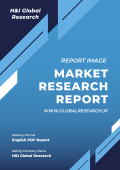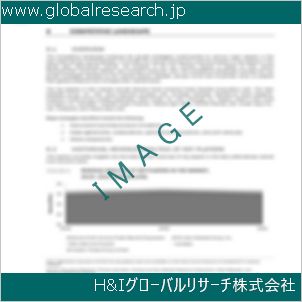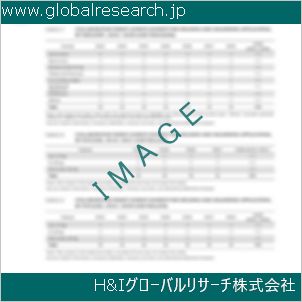目次
第1章. グローバル無水フッ化水素酸市場レポートの範囲と方法論
1.1. 研究目的
1.2. 研究方法論
1.2.1. 予測モデル
1.2.2. デスク調査
1.2.3. トップダウンとボトムアップアプローチ
1.3. 研究属性
1.4. 研究の範囲
1.4.1. 市場定義
1.4.2. 市場セグメンテーション
1.5. 研究の仮定
1.5.1. 包含と除外
1.5.2. 制限事項
1.5.3. 調査対象期間
第2章 執行要約
2.1. CEO/CXOの視点
2.2. 戦略的洞察
2.3. ESG分析
2.4. 主要な発見
第3章. グローバル無水フッ化水素酸市場動向分析
3.1. グローバル無水フッ化水素酸市場を形作る市場要因(2024–2035)
3.2. 推進要因
3.2.1. 工業国におけるフッ素化合物とアルミニウム製品の需要増加
3.2.2. アジア太平洋地域における半導体および電子機器製造の急速な成長
3.3. 制約
3.3.1. 有毒化学物質の輸送および取り扱いに関する厳格な規制枠組み
3.3.2. AHF暴露に伴う環境的・職業的健康リスク
3.4. 機会
3.4.1. 安全な貯蔵および応用技術におけるイノベーション
3.4.2. バッテリーや太陽電池コーティングなどの次世代材料におけるAHFの活用拡大
第4章. 無水フッ化水素酸のグローバル産業分析
4.1. ポーターの5つの力モデル
4.1.1. 買い手の交渉力
4.1.2. 供給者の交渉力
4.1.3. 新規参入の脅威
4.1.4. 代替品の脅威
4.1.5. 競合企業の競争
4.2. ポーターの5つの力予測モデル(2024–2035)
4.3. PESTEL分析
4.3.1. 政治
4.3.2. 経済的
4.3.3. 社会
4.3.4. 技術的
4.3.5. 環境
4.3.6. 法的
4.4. 主要な投資機会
4.5. 主要な成功戦略(2025年)
4.6. 市場シェア分析(2024–2025)
4.7. グローバル価格分析と動向(2025年)
4.8. 分析家の推奨事項と結論
第5章. グローバル無水フッ化水素酸市場規模と製品タイプ別予測(2025–2035)
5.1. 市場概要
5.2. グローバル無水フッ化水素酸市場パフォーマンス – 潜在分析(2025年)
5.3. 99.90%以上
5.3.1. 主要国別内訳推計と予測(2024–2035)
5.3.2. 地域別市場規模分析(2025–2035)
5.4. <99.90%
5.4.1. 主要国別市場規模推計と予測(2024年~2035年)
5.4.2. 地域別市場規模分析、2025–2035
第6章. グローバル無水フッ化水素酸市場規模と予測(用途別)、2025–2035
6.1. 市場概要
6.2. グローバル無水フッ化水素酸市場パフォーマンス – 潜在分析(2025年)
6.3. 化学
6.3.1. 主要国別内訳推計と予測(2024~2035年)
6.3.2. 地域別市場規模分析(2025~2035年)
6.4. 鉱業
6.4.1. 主要国別市場規模推計と予測(2024年~2035年)
6.4.2. 地域別市場規模分析、2025–2035
6.5. 冶金
6.5.1. 主要国別内訳推計と予測(2024年~2035年)
6.5.2. 地域別市場規模分析、2025–2035
6.6. その他
6.6.1. 主要国別内訳推計と予測(2024年~2035年)
6.6.2. 地域別市場規模分析、2025–2035
第7章. グローバル無水フッ化水素酸市場規模と地域別予測(2025–2035年)
7.1. 無水フッ化水素酸市場、地域別市場概要
7.2. 主要国および新興国
7.3. 北米
7.3.1. アメリカ合衆国
7.3.1.1. 製品タイプ別市場規模と予測(2025–2035年)
7.3.1.2. 用途別市場規模と予測(2025~2035年)
7.3.2. カナダ
7.3.2.1. 製品タイプ別市場規模と予測(2025年~2035年)
7.3.2.2. 用途別市場規模と予測(2025年~2035年)
7.4. ヨーロッパ
7.4.1. イギリス
7.4.1.1. 製品タイプ別市場規模と予測(2025年~2035年)
7.4.1.2. 用途別市場規模と予測(2025年~2035年)
7.4.2. ドイツ
7.4.2.1. 製品タイプ別市場規模と予測(2025~2035年)
7.4.2.2. 用途別市場規模と予測(2025年~2035年)
7.4.3. フランス
7.4.3.1. 製品タイプ別市場規模と予測(2025年~2035年)
7.4.3.2. 用途別市場規模と予測(2025年~2035年)
7.4.4. スペイン
7.4.4.1. 製品タイプ別市場規模と予測(2025~2035年)
7.4.4.2. 用途別市場規模と予測(2025年~2035年)
7.4.5. イタリア
7.4.5.1. 製品タイプ別市場規模と予測(2025~2035年)
7.4.5.2. 用途別市場規模と予測(2025年~2035年)
7.4.6. その他のヨーロッパ
7.4.6.1. 製品タイプ別市場規模と予測(2025年~2035年)
7.4.6.2. 用途別市場規模と予測(2025年~2035年)
7.5. アジア太平洋
7.5.1. 中国
7.5.1.1. 製品タイプ別市場規模と予測(2025年~2035年)
7.5.1.2. 用途別市場規模と予測(2025~2035年)
7.5.2. インド
7.5.2.1. 製品タイプ別市場規模と予測(2025年~2035年)
7.5.2.2. 用途別市場規模と予測(2025年~2035年)
7.5.3. 日本
7.5.3.1. 製品タイプ別市場規模と予測(2025年~2035年)
7.5.3.2. 用途別市場規模と予測(2025年~2035年)
7.5.4. オーストラリア
7.5.4.1. 製品タイプ別市場規模と予測(2025~2035年)
7.5.4.2. 用途別市場規模と予測(2025年~2035年)
7.5.5. 韓国
7.5.5.1. 製品タイプ別市場規模と予測(2025年~2035年)
7.5.5.2. 用途別市場規模と予測(2025年~2035年)
7.5.6. アジア太平洋地域その他
7.5.6.1. 製品タイプ別市場規模と予測(2025~2035年)
7.5.6.2. 用途別市場規模と予測(2025年~2035年)
7.6. ラテンアメリカ
7.6.1. ブラジル
7.6.1.1. 製品タイプ別市場規模と予測(2025年~2035年)
7.6.1.2. 用途別内訳規模と予測(2025~2035年)
7.6.2. メキシコ
7.6.2.1. 製品タイプ別市場規模と予測(2025年~2035年)
7.6.2.2. 用途別市場規模と予測(2025年~2035年)
7.7. 中東およびアフリカ
7.7.1. アラブ首長国連邦
7.7.1.1. 製品タイプ別市場規模と予測(2025年~2035年)
7.7.1.2. 用途別市場規模と予測(2025年~2035年)
7.7.2. サウジアラビア
7.7.2.1. 製品タイプ別市場規模と予測(2025~2035年)
7.7.2.2. 用途別市場規模と予測(2025年~2035年)
7.7.3. 南アフリカ
7.7.3.1. 製品タイプ別市場規模と予測(2025年~2035年)
7.7.3.2. 用途別市場規模と予測(2025年~2035年)
7.7.4. 中東・アフリカその他の地域
7.7.4.1. 製品タイプ別市場規模と予測(2025年~2035年)
7.7.4.2. 用途別市場規模と予測(2025年~2035年)
第8章 競合分析
8.1. 主要な市場戦略
8.2. ハネウェル・インターナショナル・インク
企業概要
主要幹部
会社概要
財務実績(データ入手状況により異なります)
製品/サービスポートフォリオ
最近の動向
市場戦略
SWOT分析
8.3. ソルベイS.A.
8.4. ダイキン工業株式会社
8.5. 東越グループ株式会社
8.6. メキシケム S.A.B. de C.V.
8.7. ランセスAG
8.8. アルケマ・グループ
8.9. エア・プロダクツ・アンド・ケミカルズ株式会社
8.10. コーラ・グローバル
8.11. フルオロケミエ・グループ
8.12. ステラ・ケミファ・コーポレーション
8.13. シノケム・グループ
8.14. 浙江省ジュファ株式会社
8.15. 森田化学工業株式会社
表の一覧
表1. グローバル無水フッ化水素酸市場、レポートの範囲
表2. グローバル無水フッ化水素酸市場規模推計および地域別予測(2024–2035年)
表3. グローバル無水フッ化水素酸市場規模推計および予測(用途別)2024–2035
表4. グローバル無水フッ化水素酸市場規模推計と予測(製品タイプ別)2024–2035
表5. 米国無水フッ化水素酸市場規模予測(2024年~2035年)
表6. カナダ無水フッ化水素酸市場規模推計と予測(2024~2035年)
表7. イギリス無水フッ化水素酸市場規模推計と予測、2024–2035
表8. ドイツ無水フッ化水素酸市場の見積もりおよび予測、2024–2035
表9. フランス無水フッ化水素酸市場規模推計と予測(2024~2035年)
表10. 中国無水フッ化水素酸市場規模推計と予測(2024~2035年)
表11. 日本 無水フッ化水素酸市場規模推計と予測、2024–2035
表12. ブラジル無水フッ化水素酸市場規模推計と予測(2024年~2035年)
表13. アラブ首長国連邦(UAE)無水フッ化水素酸市場規模推計と予測(2024年~2035年)
図表一覧
図1. グローバル無水フッ化水素酸市場、調査方法論
図2. グローバル無水フッ化水素酸市場推定手法
図3. グローバル市場規模推計および予測手法
図4. 無水フッ化水素酸市場における主要な動向(2025年)
図5. 2024~2035年のグローバルAHF市場成長見通し
図6. グローバル無水フッ化水素酸市場、ポーターの5つの力モデル
図7. 無水フッ化水素酸市場におけるPESTEL分析
図8. グローバルAHF市場、バリューチェーン分析
図9. 無水フッ化水素酸市場(製品タイプ別)、2025年と2035年
図10. AHF市場(用途別)、2025年と2035年
図11. 北米AHF市場、2025年と2035年
図12. アジア太平洋地域 AHF市場、2025年と2035年
図13. 欧州無水フッ化水素酸市場、2025年と2035年
図14. ラテンアメリカ AHF 市場、2025年と2035年
図15. 中東・アフリカ AHF 市場、2025年と2035年
図16. グローバル無水フッ化水素酸市場、企業別市場シェア分析(2025年)
Chapter 1. Global Anhydrous Hydrofluoric Acid Market Report Scope & Methodology
1.1. Research Objective
1.2. Research Methodology
1.2.1. Forecast Model
1.2.2. Desk Research
1.2.3. Top Down and Bottom-Up Approach
1.3. Research Attributes
1.4. Scope of the Study
1.4.1. Market Definition
1.4.2. Market Segmentation
1.5. Research Assumption
1.5.1. Inclusion & Exclusion
1.5.2. Limitations
1.5.3. Years Considered for the Study
Chapter 2. Executive Summary
2.1. CEO/CXO Standpoint
2.2. Strategic Insights
2.3. ESG Analysis
2.4. Key Findings
Chapter 3. Global Anhydrous Hydrofluoric Acid Market Forces Analysis
3.1. Market Forces Shaping the Global Anhydrous Hydrofluoric Acid Market (2024–2035)
3.2. Drivers
3.2.1. Rising demand for fluorochemicals and aluminum products across industrial economies
3.2.2. Rapid growth in semiconductor and electronics manufacturing in Asia Pacific
3.3. Restraints
3.3.1. Stringent regulatory framework for transportation and handling of toxic chemicals
3.3.2. Environmental and occupational health hazards associated with AHF exposure
3.4. Opportunities
3.4.1. Innovation in safe storage and application technologies
3.4.2. Growing use of AHF in next-gen materials like batteries and solar cell coatings
Chapter 4. Global Anhydrous Hydrofluoric Acid Industry Analysis
4.1. Porter’s 5 Forces Model
4.1.1. Bargaining Power of Buyer
4.1.2. Bargaining Power of Supplier
4.1.3. Threat of New Entrants
4.1.4. Threat of Substitutes
4.1.5. Competitive Rivalry
4.2. Porter’s 5 Forces Forecast Model (2024–2035)
4.3. PESTEL Analysis
4.3.1. Political
4.3.2. Economical
4.3.3. Social
4.3.4. Technological
4.3.5. Environmental
4.3.6. Legal
4.4. Top Investment Opportunities
4.5. Top Winning Strategies (2025)
4.6. Market Share Analysis (2024–2025)
4.7. Global Pricing Analysis and Trends 2025
4.8. Analyst Recommendation & Conclusion
Chapter 5. Global Anhydrous Hydrofluoric Acid Market Size & Forecasts by Product Type 2025–2035
5.1. Market Overview
5.2. Global Anhydrous Hydrofluoric Acid Market Performance – Potential Analysis (2025)
5.3. >99.90%
5.3.1. Top Countries Breakdown Estimates & Forecasts, 2024–2035
5.3.2. Market Size Analysis, by Region, 2025–2035
5.4. <99.90%
5.4.1. Top Countries Breakdown Estimates & Forecasts, 2024–2035
5.4.2. Market Size Analysis, by Region, 2025–2035
Chapter 6. Global Anhydrous Hydrofluoric Acid Market Size & Forecasts by Application 2025–2035
6.1. Market Overview
6.2. Global Anhydrous Hydrofluoric Acid Market Performance – Potential Analysis (2025)
6.3. Chemical
6.3.1. Top Countries Breakdown Estimates & Forecasts, 2024–2035
6.3.2. Market Size Analysis, by Region, 2025–2035
6.4. Mining
6.4.1. Top Countries Breakdown Estimates & Forecasts, 2024–2035
6.4.2. Market Size Analysis, by Region, 2025–2035
6.5. Metallurgical
6.5.1. Top Countries Breakdown Estimates & Forecasts, 2024–2035
6.5.2. Market Size Analysis, by Region, 2025–2035
6.6. Others
6.6.1. Top Countries Breakdown Estimates & Forecasts, 2024–2035
6.6.2. Market Size Analysis, by Region, 2025–2035
Chapter 7. Global Anhydrous Hydrofluoric Acid Market Size & Forecasts by Region 2025–2035
7.1. Anhydrous Hydrofluoric Acid Market, Regional Market Snapshot
7.2. Top Leading & Emerging Countries
7.3. North America
7.3.1. U.S.
7.3.1.1. Product Type Breakdown Size & Forecasts, 2025–2035
7.3.1.2. Application Breakdown Size & Forecasts, 2025–2035
7.3.2. Canada
7.3.2.1. Product Type Breakdown Size & Forecasts, 2025–2035
7.3.2.2. Application Breakdown Size & Forecasts, 2025–2035
7.4. Europe
7.4.1. UK
7.4.1.1. Product Type Breakdown Size & Forecasts, 2025–2035
7.4.1.2. Application Breakdown Size & Forecasts, 2025–2035
7.4.2. Germany
7.4.2.1. Product Type Breakdown Size & Forecasts, 2025–2035
7.4.2.2. Application Breakdown Size & Forecasts, 2025–2035
7.4.3. France
7.4.3.1. Product Type Breakdown Size & Forecasts, 2025–2035
7.4.3.2. Application Breakdown Size & Forecasts, 2025–2035
7.4.4. Spain
7.4.4.1. Product Type Breakdown Size & Forecasts, 2025–2035
7.4.4.2. Application Breakdown Size & Forecasts, 2025–2035
7.4.5. Italy
7.4.5.1. Product Type Breakdown Size & Forecasts, 2025–2035
7.4.5.2. Application Breakdown Size & Forecasts, 2025–2035
7.4.6. Rest of Europe
7.4.6.1. Product Type Breakdown Size & Forecasts, 2025–2035
7.4.6.2. Application Breakdown Size & Forecasts, 2025–2035
7.5. Asia Pacific
7.5.1. China
7.5.1.1. Product Type Breakdown Size & Forecasts, 2025–2035
7.5.1.2. Application Breakdown Size & Forecasts, 2025–2035
7.5.2. India
7.5.2.1. Product Type Breakdown Size & Forecasts, 2025–2035
7.5.2.2. Application Breakdown Size & Forecasts, 2025–2035
7.5.3. Japan
7.5.3.1. Product Type Breakdown Size & Forecasts, 2025–2035
7.5.3.2. Application Breakdown Size & Forecasts, 2025–2035
7.5.4. Australia
7.5.4.1. Product Type Breakdown Size & Forecasts, 2025–2035
7.5.4.2. Application Breakdown Size & Forecasts, 2025–2035
7.5.5. South Korea
7.5.5.1. Product Type Breakdown Size & Forecasts, 2025–2035
7.5.5.2. Application Breakdown Size & Forecasts, 2025–2035
7.5.6. Rest of Asia Pacific
7.5.6.1. Product Type Breakdown Size & Forecasts, 2025–2035
7.5.6.2. Application Breakdown Size & Forecasts, 2025–2035
7.6. Latin America
7.6.1. Brazil
7.6.1.1. Product Type Breakdown Size & Forecasts, 2025–2035
7.6.1.2. Application Breakdown Size & Forecasts, 2025–2035
7.6.2. Mexico
7.6.2.1. Product Type Breakdown Size & Forecasts, 2025–2035
7.6.2.2. Application Breakdown Size & Forecasts, 2025–2035
7.7. Middle East and Africa
7.7.1. UAE
7.7.1.1. Product Type Breakdown Size & Forecasts, 2025–2035
7.7.1.2. Application Breakdown Size & Forecasts, 2025–2035
7.7.2. Saudi Arabia
7.7.2.1. Product Type Breakdown Size & Forecasts, 2025–2035
7.7.2.2. Application Breakdown Size & Forecasts, 2025–2035
7.7.3. South Africa
7.7.3.1. Product Type Breakdown Size & Forecasts, 2025–2035
7.7.3.2. Application Breakdown Size & Forecasts, 2025–2035
7.7.4. Rest of Middle East & Africa
7.7.4.1. Product Type Breakdown Size & Forecasts, 2025–2035
7.7.4.2. Application Breakdown Size & Forecasts, 2025–2035
Chapter 8. Competitive Intelligence
8.1. Top Market Strategies
8.2. Honeywell International Inc.
Company Overview
Key Executives
Company Snapshot
Financial Performance (Subject to Data Availability)
Product/Services Port
Recent Development
Market Strategies
SWOT Analysis
8.3. Solvay S.A.
8.4. Daikin Industries Ltd.
8.5. Dongyue Group Co., Ltd.
8.6. Mexichem S.A.B. de C.V.
8.7. Lanxess AG
8.8. Arkema Group
8.9. Air Products and Chemicals, Inc.
8.10. Koura Global
8.11. Fluorchemie Group
8.12. Stella Chemifa Corporation
8.13. Sinochem Group
8.14. Zhejiang Juhua Co., Ltd.
8.15. Morita Chemical Industries Co., Ltd.
❖ 免責事項 ❖
http://www.globalresearch.jp/disclaimer












